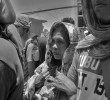In this first foray in Today’s View, I want to debunk the misconception that women in prostitution are deviants and, therefore, have to be regarded as outcasts. Women suffer from such a categorization as if personality disorders have to be corrected and that rehabilitation is of utmost concern for the humanitarians. Here lies the psychoanalytic framework as a further analysis for women in prostitution.
By MAE FE ANCHETA-TEMPLA
In the late 1990’s, a consolidated statement from writers labeling women in prostitution as deviants strongly declare that while prostitution has existed as a powerful and threatening system, the individual prostitute, however, could be redefined as a powerless and sympathetic figure intent on self-destruction rather than capable of societal construction.
In this first foray in Today’s View, I want to debunk the misconception that women in prostitution are deviants and, therefore, have to be regarded as outcasts. Women suffer from such a categorization as if personality disorders have to be corrected and that rehabilitation is of utmost concern for the humanitarians. Here lies the psychoanalytic framework as a further analysis for women in prostitution.
Indeed, this focuses on the individual rather than the environmental forces that affect and influence a person’s actions. This manifests an analytical framework devoid of gender and class.
Since the 1970s, sex trade has flourished because women are more often dragged into prostitution forcibly by circumstance. The increase in number of Filipino women in prostitution is directly connected to the economic landscape. And it will continue to exist for as long as the state and its apparatuses give high premium to male sexual needs.
Gagnon (1977) as cited by Eviota (1992) pursued further that such proliferation and rapid expansion of sex trade is better explained in terms of women’s lack of options for adequately paid productive work. Gagnon further asserted that when economic options for women are not present, or exist as mere low-paying options, women will be lured into prostitution.
Thus, prostitution is not an aberrant sexual behavior directed to satisfy male sexual needs.
In all this, the issue of legalization of prostitution alarms a good number of women’s rights activists globally. They asserted that legalizing prostitution raises important social, ethical, economic and political issues — issues which far exceed immediate individual interests.
How can one speak about “consent” and about “choice” when the average age of entry into prostitution is 13, when everyone knows that it is economic and emotional misery which drives more and more women and children to sell their bodies and to be subjected to brutal measures of training by pimps, traffickers and criminalized gangs?
Legalizing prostitution, therefore, does not constitute a true alternative to the increasing misery of women in prostitution. It is disastrous on the relationship between men and women, a distortion on the image of women, and reinforces the impression that all women are objects of prostitution.
On September 8, 1995, the Ramos administration promulgated the 1995-2025 Philippine Plan for Gender Responsive Development (PPGD) through Executive Order No. 273. It views prostitution as a human rights violation and identifies decriminalization of women in prostitution as a starting point in addressing the problem.
But in spite of the policy framework, the government’s administrative and legislative action to prostitution of adult women has remained untouched. In fact, existing laws remain in conflict with the PPGD.
Concretely, the entire Article 202 of the Revised Penal Code, which penalizes vagrants and prostitutes, allows law enforcers to make scapegoats of women in their law enforcement drives against prostitution. It also renders women more vulnerable to exploitation and abuse, denies them the protection they deserve, and prevents them from enforcing their rights and seeking redress when necessary (WLB, 1999). Many women in prostitution are arrested on charges of vagrancy, not prostitution.
On the other hand, employers of entertainment establishments are made responsible for ensuring that women are “checked” under threat of losing the former’s business licenses. Prostituted women are obliged to submit to a periodic physical and medical check-up but customers are free to receive services even without any health clearance. To sum it up, social hygiene clinics are legally sanctioned and operated by the government.
Since the removal of the US military bases from the Philippines in 1991, new ploys were installed to give way to the covert US intervention in the country which historically bears on the Filipino women’s struggle against exploitation.
In 1998, the Philippine government allowed another form of foreign intervention when it signed the Visiting Forces Agreement (VFA) which opens the Philippine territory to the United States army’s exercises in the guise of capability building for the Philippine army. The Migrante 2001 Reports revealed the trafficking of Filipinas in areas where US troops are stationed.
Since 1998, women in the south, including myself, have opposed the VFA. We fear further human rights violations, degradation and rape of women and children brought about by such disguised opportunity.
Another form of “legal” prostitution is through visa. More Filipino women are recruited and sent to South Korea using the E6 visa, an artistic performer visa. Around 250 were sent on an E6 visa in 1994 and 1,365 in 1997. During the same period, a survey by the Saewoomtuh or Sprouting Land Center for Prostituted Women in Seoul showed that almost 85 percent of all entertainers in Korea were Filipinas.
Thus, any attempt to legalize prostitution manifests subscription to an ideology that prostitution is work and treats women’s bodies as commodities for sale. Offhand this may be a pendulum swing, where women are no longer blamed for immorality and pathology but is a negative affirmation of human resources for sexual services. When a society could not provide for its people with decent jobs, homes, regular meals and basic education, women and girl children’s vulnerability become more pronounced as they are increasingly targets for profits in sexual gratification business.
Prostitution remains one of the forms of violence against women, a women human right violation that needs to be addressed comprehensively in light of the historic and systemic characteristics of poverty in the country.
Prof. Mae Fe Ancheta-Templa is a women and children rights activist, social worker, and chair of the Social Work Program of the Assumption College of Davao, Southern Philippines. Her fields of interest in research include gender, women, children, Moro and indigenous peoples, psychosocial help, community organization, indigenous social work and social administration. She was a research fellow at the University of Cape Town, South Africa.

![[STANDPOINT] Illegal drugs and the NIMBY mindset](https://davaotoday.com/wp-content/uploads/2016/09/Mags-Maglana_UPMIN-Sept.-20-110x100.jpg)








